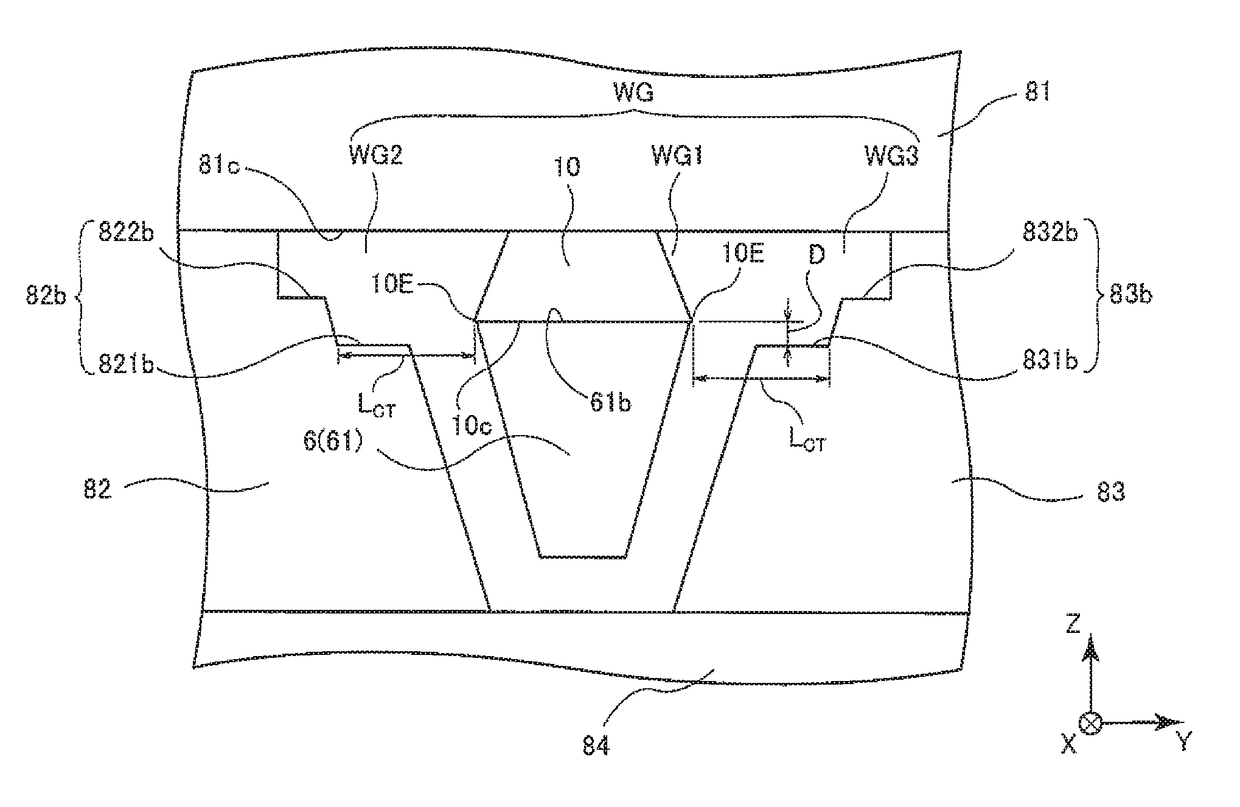Magnetic recording head with spin torque oscillator, head gimbal assembly and magnetic recording apparatus
a technology of spin torque oscillator and magnetic recording head, which is applied in the direction of special recording techniques, instruments, and heads with metal sheet cores, etc., can solve the problems of inability to record into the magnetic recording medium, inability to control the spin torque oscillator b>10/b>′, and decreased the magnetic stability of the magnetic grains, so as to improve the oscillation of the spin torque oscillator
- Summary
- Abstract
- Description
- Claims
- Application Information
AI Technical Summary
Benefits of technology
Problems solved by technology
Method used
Image
Examples
example 1
[0089]An amplitude ΔM (T) of the magnification of the side shields 82 and 83 at the time of oscillation of the spindle torque oscillator 10 was obtained by simulation using an analysis model of the magnetic recording head 1 having the configuration shown in FIG. 4 and FIG. 7A (E1). This simulation analysis experiment was conducted using a three-dimensional Finite-Difference Time-Domain method (FDTD method), which is the electromagnetic field analysis.
[0090]As the magnetic recording head 1, a model where the main magnetic pole layer 6 (the main magnetic pole part 61) was formed with CoFe, and the trailing shield 81, the side shields 82 and 83 and the leading shield 84 were formed with NiFe was adopted.
[0091]In the model above, a gap D between the end surfaces 82b and 83b of the side shields 82 and 83 and the end surface 10c of the spin torque oscillator 10 (the end surface 61b of the main magnetic pole part 61) along the down track direction was set at 5 nm. Simulation results are sh...
example 2
[0092]In the model above, the amplitude ΔM of the magnification of the side shields 82 and 83 was obtained by simulation in the same manner as in Example 1, except for setting the gap D between the end surfaces 82b and 83b of the side shields 82 and 83 and the end surface 10c of the spin torque oscillator 10 (the end surface 61b of the main magnetic pole part 61) along the down track direction at 10 nm (E2). Simulation results are shown in FIG. 12.
example 3
[0093]In the model above, the amplitude ΔM of the magnification of the side shields 82 and 83 was obtained by simulation in the same manner as in Example 1, except for setting the gap D between the end surfaces 82b and 83b of the side shields 82 and 83 and the end surface 10c of the spin torque oscillator 10 (the end surface 61b of the main magnetic pole part 61) along the down track direction at 20 nm (E3). Simulation results are shown in FIG. 12.
PUM
| Property | Measurement | Unit |
|---|---|---|
| length | aaaaa | aaaaa |
| thickness | aaaaa | aaaaa |
| length LCT | aaaaa | aaaaa |
Abstract
Description
Claims
Application Information
 Login to View More
Login to View More - R&D
- Intellectual Property
- Life Sciences
- Materials
- Tech Scout
- Unparalleled Data Quality
- Higher Quality Content
- 60% Fewer Hallucinations
Browse by: Latest US Patents, China's latest patents, Technical Efficacy Thesaurus, Application Domain, Technology Topic, Popular Technical Reports.
© 2025 PatSnap. All rights reserved.Legal|Privacy policy|Modern Slavery Act Transparency Statement|Sitemap|About US| Contact US: help@patsnap.com



